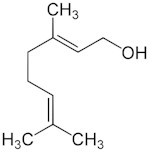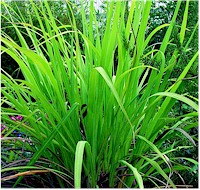Geraniol is a natural active ingredient of plant origin used in veterinary medicine mainly in dogs and cats against some external parasites (lice, fleas, flies, etc). It is also used against agricultural and household pests.
Common name: GERANIOL
Other names: (trans)-3,7-Dimethyl-2,6-octadien-1-oll
Type: INSECTICIDE, REPELLENT
Some plants where it is found
- Coriandrum sativum (Chinese parsley, cilantro, coriander)
- Cymbopogon martinii (palmarosa)
- Geranium spp (cranesbills, several species)
- Laurus nobilis (laurel)
- Rosa spp (roses, several species)
- Thymus vulgaris (thyme)
- etc.
CHEMICAL STRUCTURE

EFFICACY AGAINST PARASITES
Type of action: insecticide, repellent
Main veterinary parasites controlled: fleas, lice, ticks, etc.
Mechanism of action: Extremely little is known about the mechanism of action of geraniol in insects. There are reports that it affects chitin in the cuticle causing dehydration and suffocation. A larvicidal and ovicidal effect has also been reported for some species, as well as a repellent effect on certain mosquitoes and ticks.
A "crushing" efficacy should not be expected from natural products, comparable to that of modern synthetic insecticides, which are more potent and persistent than any natural compound. Simplifying, it can be said that natural active ingredients can be useful in places or seasons with low parasite challenge, but may be insufficient for controlling well established parasite populations (fleas, ticks, mites, etc.) in pets, let alone in livestock.
Efficacy against a specific parasite depends on the delivery form and on the dose administered. Check the labels of the products available in your country.
Click here for general information on features and characteristics of PARASITICIDES.
SAFETY
Oral LD50, rat, acute*: 3600 mg/kg
Dermal LD50, mouse, acute*: >5000 mg/kg
* These values refer to the active ingredient. Toxicity has to be determined for each formulation as well. Formulations are usually significantly less toxic than the active ingredients.
Geraniol is a moderate skin irritant and can cause allergies. Exposed to air, its oxidation products are more irritant and allergenic. Otherwise geraniol is considered as rather safe for humans, domestic animals and the environment.
It must be remembered that the natural origin does not guarantee that such compounds are less toxic than the synthetic parasiticides. They are as "chemical" as the synthetic ones. Toxicity is a matter of dose!
General information on the safety of veterinary antiparasitics is available in specific articles in this site (click to visit):
- General safety of antiparasitics for domestic animals
- General safety of antiparasitics for humans
- General safety of antiparasitics for the environment
MARKETING & USAGE
Geraniol is the main component (70-85%) in the essential oil of palmarosa and is also very abundant in rose and citronella oils. Nowadays it is produced either through industrial extraction from such oils, through chemical synthesis, or through genetically engineered microorganisms.
Use in LIVESTOCK: Extremely scarce, mainly as ingredient in some essential oils
Use in HORSES: Extremely scarce, mainly as ingredient in some essential oils
Use in DOGS & CATS: Very scarce
Use in human medicine: Yes, mainly in traditional medicine in some cultures.
Use in public/domestic hygiene: Yes, rather scarce
Use in agriculture: Yes, rather scarce
PARASITE RESISTANCE
Reported in livestock & horses: NO
Reported in pets: NO
Reported in other uses: NO
Learn more about parasite resistance and how it develops.
ADDITIONAL INFORMATION

vGeraniol is a monoterpenoid and al alcohol naturally produced by numerous plants. It makes 70-85% of palmarosa oil (Cymbopogon martinii). It has a characteristic rose odor that makes it an important constituent of many flagrances in perfumes and cosmetics, in the food industry and in home-care products. It is also used in the industrial production of citronellal and citronellol, and as an additive in the tobacco industry.
Direct usage as an insecticides is very modest, only in horticulture, against a few domestic pests (cockroaches, ants, termites, etc) or against a few pet parasites (fleas, lice, ticks), but more as a repellent than as insecticide. It is also used a few as a fungicide in agriculture.
Geraniol shares two features with many other natural insecticides: it is rather volatile and is unstable when exposed to sunlight. Consequently its effect in animals exposed to sunlight is very short: a few days or even only a few hours. This means that protection of the treated animals against re-infestations (residual effect) is virtually inexistent. This is particularly unfavorable for livestock that would need to be treated very frequently. However, for the same reason they do not leave chemical residues in food commodities (meat, milk, eggs, etc.), which is a benefit sought by organic producers.
Another disadvantage of many "natural products" extracted from plants is that quality (and thus efficacy) may vary, even if used following the label instructions, because producing extracts from heterogeneous plant materials is often less reliable than chemical synthesis.
Finally it must be said that in many countries registration of so-called "natural products" does not need a (serious) proof of efficacy, quality and safety as pesticides or veterinary medicines. This means that many such products have not been seriously tested in clinical trials in the field and consequently their efficacy and/or safety may not be granted. For such products, getting a market authorization does not need a substantial investment, which explains why there are so many brands in most countries.
- Click here to view the list of all technical summaries of natural antiparasitic active ingredients in this site.
- Click here to view the list of all technical summaries of antiparasitic active ingredients in this site.
- Click here to visit the article on medicinal plants with antiparasitic properties in this site.